The Stalinist skyscrapers in Moscow are amazingly beautiful, monumental and majestic buildings, behind which for more than half a century a train of mystical secrets and fascinating stories has been stretching.  Let's talk about these unique buildings, their history and legends.
Let's talk about these unique buildings, their history and legends.
7 Stalinist skyscrapers in Moscow
Historical references indicate that Stalin planned the construction of eight buildings. The very fact of their construction was supposed to serve as a demonstration of the power of the Soviet Union - the state that won the terrible war, which stood and liberated half of Europe. It is believed that the location of the houses was planned in a special way, following the example of the Egyptian pyramids, and they were created to accumulate energy flows. We will not go into the background of this decision and answer the question of how many Stalinist skyscrapers in Moscow, noting only that almost immediately after the war, seven interesting elite buildings were erected that became a legend of Soviet architecture and covered in riddles and secrets.
The eighth skyscraper has not been erected, and we will find out the reasons why this did not happen below. As for the rest, thanks to Stalin's ambitions, the capital today is decorated with unique architectural buildings, the laying of which took place simultaneously on September 7, 1947, on the day that became the city’s birthday.
High-rise first: the house on Kotelnicheskaya
Answering the question, how many Stalinist skyscrapers are in Moscow, we will begin a brief overview from the House of Artists on Kotelnicheskaya Naberezhnaya (d. 1, metro Kitay Gorod). It was designed by architects Chechulin D.N. and Rostkovsky A.K. and is located on Shvivaya Gorka in Zayauzye, a very beautiful and cozy place. And the building is no less interesting: a 32-story building, built in the so-called Stalinist Empire style, it is decorated with bas-reliefs and obelisks, and has a height of 176 m. The house is conceived and built as a reference point for all the streets leading to the river, and closes the east the prospect of the Moskva River relative to the Kremlin. The construction of the Stalinist skyscrapers in Moscow was carried out for the most part by prisoners, they often posed for sculptures and compositions decorating the building. The house on Kotelnicheskaya was connected to an already completed building - a 9-storey residential building for security officers and their families - and perfectly entered the general architectural complex. This is probably why all the construction work begun in 1949 was supervised by the Ministry of Internal Affairs. The construction was completed in 1952.
And the building is no less interesting: a 32-story building, built in the so-called Stalinist Empire style, it is decorated with bas-reliefs and obelisks, and has a height of 176 m. The house is conceived and built as a reference point for all the streets leading to the river, and closes the east the prospect of the Moskva River relative to the Kremlin. The construction of the Stalinist skyscrapers in Moscow was carried out for the most part by prisoners, they often posed for sculptures and compositions decorating the building. The house on Kotelnicheskaya was connected to an already completed building - a 9-storey residential building for security officers and their families - and perfectly entered the general architectural complex. This is probably why all the construction work begun in 1949 was supervised by the Ministry of Internal Affairs. The construction was completed in 1952.
Bird of Happiness on Shivaya Gorka
Upon surrender, one wing of the house was given to the military, the second - to the creative intelligentsia. Many famous Soviet artists at different times lived and live in it. In total, the complex has 700 apartments, there are shops, a post office and a movie theater "Illusion". Note that the house entered the elite of the Moscow housing stock, and, of course, the rent was quite impressive, not everyone could afford such expenses, but with someone’s light hand the house was for a long time called the Bird of Happiness on Shvivaya Gorka. He became the first commissioned object representing the Stalinist skyscrapers in Moscow. The photo available in the article emphasizes the monumentality and beauty of this legendary building.
High-rise second: the house at the Red Gate
Built at the very peak point of the Garden Ring, the 138-meter building is located at the exit of the Krasniye Vorota metro station, the name of which quickly became its landmark.  House at the Red Gate on the street. Sadovaya-Spasskaya, d. 21 / Kalanchevskaya, d.1 was designed by architects A. Dushkin and B. Mezentsev, and the construction was led by the Ministry of Railways. The central building of the 24-story giant was originally intended for the Ministry of Transport Engineering. The side buildings are residential, they contain 284 apartments. The construction was unique, since it was supposed not to interfere with the functioning of the exit from the Krasniye Vorota metro station, for which the original method of freezing the foundation pit and erecting the building with a deviation laid down, which was eliminated during the shrinkage of the house, was applied. The experiment was successful: the foundation slab withstood the load, and the exit from the subway functioned as intended.
House at the Red Gate on the street. Sadovaya-Spasskaya, d. 21 / Kalanchevskaya, d.1 was designed by architects A. Dushkin and B. Mezentsev, and the construction was led by the Ministry of Railways. The central building of the 24-story giant was originally intended for the Ministry of Transport Engineering. The side buildings are residential, they contain 284 apartments. The construction was unique, since it was supposed not to interfere with the functioning of the exit from the Krasniye Vorota metro station, for which the original method of freezing the foundation pit and erecting the building with a deviation laid down, which was eliminated during the shrinkage of the house, was applied. The experiment was successful: the foundation slab withstood the load, and the exit from the subway functioned as intended.
Today, in addition to the mentioned Ministry, the building houses many organizations: the Moscow Currency Exchange, the trade union of railway and transport construction, Transstroy Corporation, Transport Publishing House, a restaurant, a bank, and shops.
At the beginning of the 19th century on this site was the mansion of Major General Tolya, where M. Yu. Lermontov was born. In memory of this, a memorial plaque is installed on the pediment of the building.
High-rise third: hotel "Leningradskaya"
The 17-story building representing the Stalinist skyscrapers in Moscow, the Leningradskaya Hotel, is located on 21/40 Kalanchevskaya Street (Kalanchevskaya or Krasnye Vorota metro stations) and is one of the most famous hotels in the capital. Finished in 1954, the 136-meter-high house, designed by architects Polyakov L.M. and Boretsky A. B., elegantly organically blended into the existing ensemble of Komsomolskaya Square. 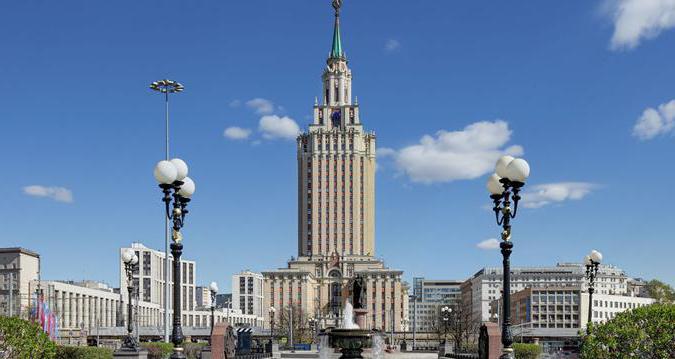 This skyscraper is distinguished from others by the elegance of the exterior decoration and the refined splendor of the interior decoration, which includes elements of temple architecture and Moscow baroque.
This skyscraper is distinguished from others by the elegance of the exterior decoration and the refined splendor of the interior decoration, which includes elements of temple architecture and Moscow baroque.
Since this building was erected as a front facade of the capital, it has become the most luxurious and expensive. 1 sq. meter cost 21 thousand rubles, while 1 m2 at home on Kotelnicheskaya cost 5.5 thousand rubles. The history of the Stalinist skyscrapers in Moscow does not know more expensive construction at that time. The lobby is decorated with bas-reliefs, and unique bronze garland chandeliers illuminate 5 floors. The total area of 330 hotel rooms is 25 thousand m2.
Fourth High-Rise - Aviators House
At the end of 1954, the Stalinist skyscrapers in Moscow replenished the building of the Aviators House on Kudrinskaya Square (before 1992 - Vosstaniya Square), 1, near the Barrikadnaya metro station, designed by architects M.V. Posokhin. and Mndoyants A.A. Consisting of a central (24 floors) and side (18 floors each) buildings, the building together with the spire reaches a height of 156 meters.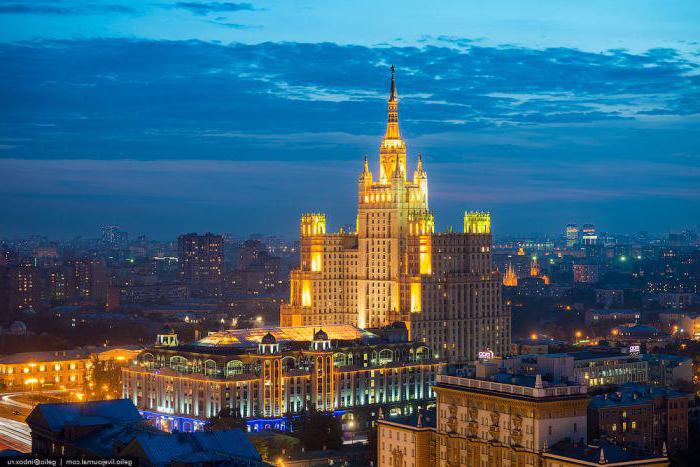
450 apartments were distributed among the workers upon delivery of the house aviation industry nomenclature of the Central Committee of the CPSU, test pilots and cosmonauts. The building is also distinguished by luxury and sophistication. Filmmakers often use the interiors of Moscow skyscrapers in the filming of feature and documentary films.
Today, the Directorate of the company responsible for the operation of a number of high-rise buildings in Moscow, including this building, is located in the house. In the premises of the basement and the ground floor there are currently shops, a bowling club, cellars are given for underground parking and garages.
Fifth high-rise - Foreign Ministry building
In 1953, another high-rise building was commissioned on Smolenskaya-Sennaya Square (Building 32) - a 27-story building, which houses three ministries - foreign affairs, trade and foreign economic relations. The height of the building is 172 m, the area of the premises is 65 thousand m2. 28 elevators are constantly operating, 18 of which are high-speed.
Designed by architects Gelfreich V.G. and Minkus M.A., the Ministry of Foreign Affairs is the only high-rise building that does not have a five-pointed star on the spire, but initially it was not in the plan. This happened because in the construction an unusual method was used to construct the building frame at full height.Historians testify that Stalin insisted on such a tower style, but according to experts, the installation of a spire would create a load that the building could not withstand. Subsequently, a lightweight spire was installed. Another attraction on the facade of the house is the emblem of the USSR, installed at 114-meter height and remains there to this day.
Sixth high-rise - hotel "Ukraine"
The hotel, located on Kutuzovsky Prospect, 2/1, near the Kievskaya metro station, on the Filevskaya line, was designed by a group of eminent architects - Mordvinov A.G., Kalish V.G., Altarzhevsky V.K. and others. Various project details Developed by specialists of up to two thousand people.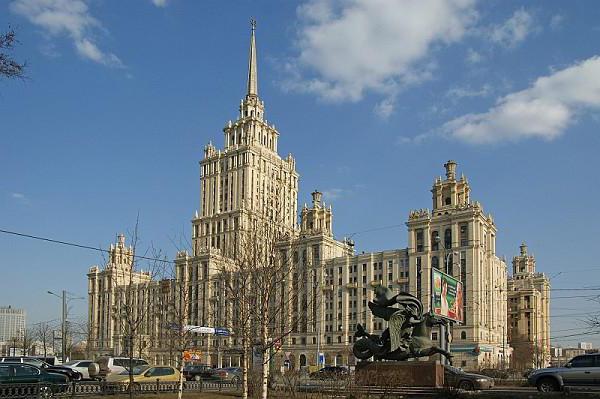
The building occupies more than 88 thousand meters2, its height is 206 m. taking into account the 73-meter spire. From the point of view of architecture, this structure is distinguished by the perfection of composition: the central building with a tower crowned with a spire balances the clear monumentality of the wings, and the corner towers and flowerpots imitating sheaves of wheat emphasize the palace style of the building. The central building was occupied by a hotel, the side ones were given for housing.
The hotel was opened on May 25, 1957. At that time, Ukraine was the largest in Europe, today it has acquired the status of a luxury hotel of European level.
Seventh skyscraper: Moscow State University
The list titled “Seven Stalin's skyscrapers in Moscow” includes the new building of the 36-story university building of Moscow State University named after MV Lomonosov on Vorobyovy Gory (Building 1), which first opened its doors on September 1, 1953.
The design of the skyscraper was carried out by a group of architects under the leadership of L. V. Rudnev. During the construction of the building, the latest technical solutions for that time were used, which made it possible to successfully build a building of variable height on very difficult soils. The design of the facades and the creation of sculptural groups was entrusted to the workshop of Vera Mukhina. Given the 58-meter spire, the height of the building is 240 m, and thanks to the stepped structure, the first two floors have a large area that allows you to create a huge lobby on the 1st floor, and on the 2nd floor there are two majestic columned halls decorated with sculptures of great scientists. The luxury of the interior of this temple of science is striking - marble staircases and various decorative elements resemble the Golden Age palaces. Audiences are placed on the premises starting from the 3rd floor.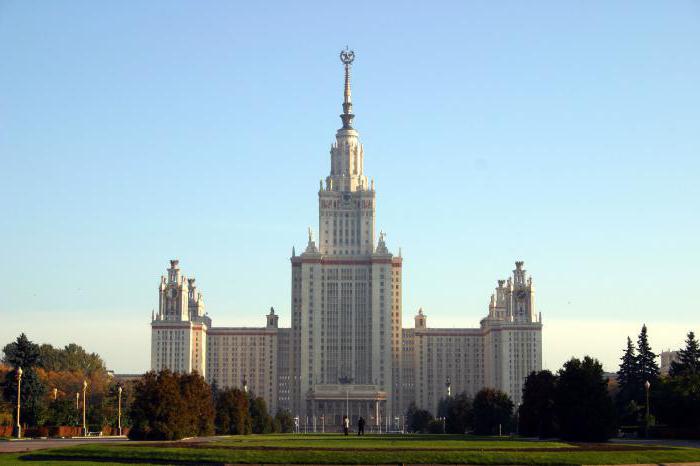
The central building (sector “A”) houses administrative services, faculties, an assembly hall and a recreation center of Moscow State University. The side buildings are given for housing for the teaching staff and student hostels, there are basement and technical floors. Until recently, the building of Moscow State University was the tallest in Europe.
Administration building in Zaryadye
The Stalinist skyscrapers in Moscow were originally planned in the amount of 8 buildings, and they began and even built a two-tier concrete bunker and a technical floor designed by architect D. Chechulin.
It was planned to accommodate the People's Commissariat of Heavy Engineering, but after Stalin's death at the stage of completion of construction, all work was stopped, and the construction of the house was suspended. In 1967, on the existing foundation, the Rossiya Hotel was built, which now no longer exists. The capital’s government plans to set up a large park with an entertainment area on this site.
Finally
Thus, the Stalinist skyscrapers in Moscow - house legends, which at that time became the real embodiment of the prestige of the country that won the war, and a symbol of the power of the USSR, today are the hallmark of the capital.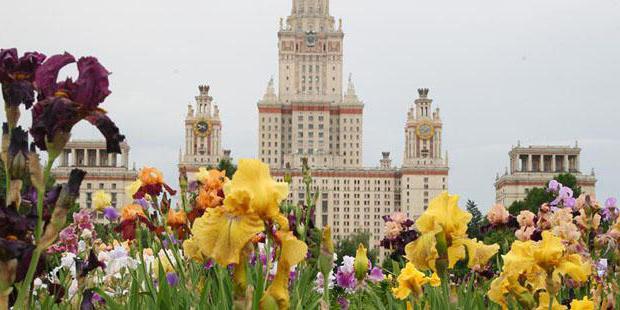 All these magnificent buildings are amazing, you can talk a lot and interestingly about each of them, but it is difficult to do this within the framework of one article, because the Stalinist skyscrapers in Moscow, the addresses of which the whole world knows, are an interesting phenomenon in world architecture.
All these magnificent buildings are amazing, you can talk a lot and interestingly about each of them, but it is difficult to do this within the framework of one article, because the Stalinist skyscrapers in Moscow, the addresses of which the whole world knows, are an interesting phenomenon in world architecture.








